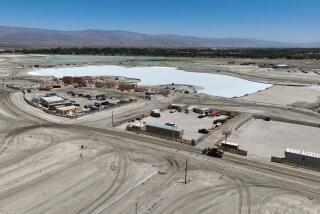Golf Courses Are Gobbling Up Too Much Open Space : The Valley has some of the last morsels of valuable undeveloped vistas and wildlife. They shouldn’t be turned into more fairways and greens.
- Share via
Golf--a great game. Millions of us pit ourselves regularly against that small white ball, watching the sweet shot arc toward the green, cursing the hook into the rough. A splendid, tantalizing obsession. (And the mild exercise is good for you.)
There are said to be close to 200 golf courses in Los Angeles County. But that never seems to be enough. Someone is always dreaming of an exclusive golf course with a pot of gold on the 18th green. Not for the average duffer but for the person who won’t miss the $75,000 membership fee.
And with suitable sites becoming scarce, the golf courses are moving into valuable open space and undeveloped natural areas.
Take Cosmo World Corp., which wants to build a golf course on 355 acres in Big Tujunga Wash in the northeast Valley. Recently, the headlines were telling us that Cosmo was about to bulldoze the slender-horned spineflower on its property and was giving the U. S. Fish and Wildlife Service 10 days to “salvage” the plants. Talk about arrogance! (Cosmo extended the waiting period to 90 days when the Fish and Wildlife Service threatened to sue.)
*
It isn’t just this little-known four-inch flower that is at risk. It is the habitat itself. The alluvial scrub of Tujunga Wash supports 30 rare plants and animals as well as the spineflower, and is officially designated as an environmentally sensitive area.
The Wash is a long natural flood plain that flows from the wild Big Tujunga River to Hansen Dam. It has a raw, startling beauty, a remnant of the desert that Los Angeles used to be. It is inconceivable that anyone can consider building a playground for the affluent few in a thriving natural community like this.
Then there’s the hotly disputed development in Topanga Canyon, with 97 luxury homes centered around another exclusive golf course. The 257-acre Canyon Oaks project just south of Mulholland Drive will destroy a great swath of chaparral that harbors deer, bobcats, gray foxes and a variety of birds.
Most Topanga residents are opposed to this menace to their treasured rustic lifestyle. They talk of increased traffic on two-lane, winding Topanga Canyon Boulevard. They are concerned about herbicides and fertilizers from the golf course contaminating Topanga Creek, and they’re afraid changes in the creek’s watershed will imperil their homes downstream during the rainy season.
Topanga’s rugged defenders are fighting Disney-owned Canyon Oaks as they have other developments on the same site for 15 years. The struggle this time is tougher, but they are determined to win.
Lest we forget, Bob Hope’s Jordan Ranch was to have been a golfer’s paradise with a real championship golf course (and the usual luxury homes) that would rival the Riviera Country Club, home of the L.A. Open.
*
Fortunately, the National Park Service acquired the ranch for the Santa Monica Mountains National Recreation Area, which was established to preserve and enhance the scenic natural and historic setting (golf courses not included).
There’s more . . .
* The vast Ahmanson Ranch in the hills north of U. S. 101, near Las Virgenes Road, has plans for two golf courses.
* Pierce College’s farm is an attractive green contrast to the glassy towers of the Warner Center next door in Woodland Hills.
Along with cows, horses and sheep, the farm has been the winter host for more than a thousand Canada geese for many years. Strapped for money, the college is considering leasing or selling the farm. The president has openly talked of a golf course.
* Every so often, the spacious acres of the Chatsworth Reservoir have been proposed for a golf course.
And so it goes. The Valley and its neighboring towns to the west hold the last morsels of “country,” of undeveloped vistas, of wildlife.
Golf is good, golf is great. But sometimes golf courses seem to be creatures out of “Jurassic Park,” relentlessly chasing down and chewing up the morsels of open space.
More to Read
Sign up for The Wild
We’ll help you find the best places to hike, bike and run, as well as the perfect silent spots for meditation and yoga.
You may occasionally receive promotional content from the Los Angeles Times.






